Tsar
Tsar (/zɑːr, sɑːr/ or /tsɑːr/), also spelled czar, or tzar or csar, is a title used to designate East and South Slavic monarchs or supreme rulers of Eastern Europe, originally the Bulgarian monarchs from 10th century onwards, much later a title for two rulers of the Serbian State, and from 1547 the supreme ruler of the Tsardom of Russia and the Russian Empire. In this last capacity it lends its name to a system of government, tsarist autocracy or tsarism. The term is derived from the Latin word caesar, which was intended to mean "emperor" in the European medieval sense of the term—a ruler with the same rank as a Roman emperor, holding it by the approval of another emperor or a supreme ecclesiastical official (the Pope or the Ecumenical Patriarch)—but was usually considered by western Europeans to be equivalent to king, or to be somewhat in between a royal and imperial rank.
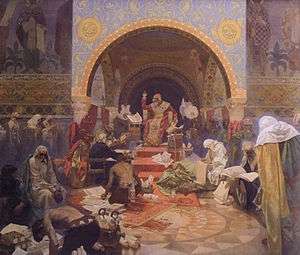
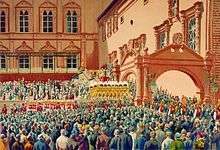
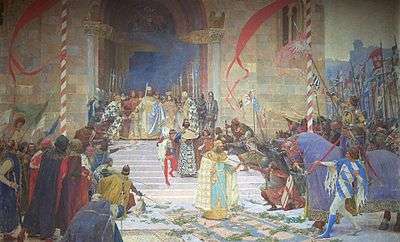
"Tsar" and its variants were the official titles of the following states:
- First Bulgarian Empire, in 919–1018
- Second Bulgarian Empire, in 1185–1396
- Serbian Empire, in 1346–1371
- Tsardom of Russia, in 1547–1721 (replaced in 1721 by imperator, but still remaining in use, also officially in relation to several regions until 1917)
- Tsardom of Bulgaria, in 1908–1946
The first ruler to adopt the title tsar was Simeon I of Bulgaria.[2] Simeon II, the last tsar of Bulgaria, is the last person to have borne the title tsar.
Meaning in Slavic languages
The title tsar is derived from the Latin title for the Roman emperors, caesar.[3] In comparison to the corresponding Latin word imperator, the Byzantine Greek term basileus was used differently depending on whether it was in a contemporary political context or in a historical or Biblical context. In the history of the Greek language, basileus had originally meant something like "potentate". It gradually approached the meaning of "king" in the Hellenistic Period, and it came to designate "emperor" after the inception in the Roman Empire. As a consequence, Byzantine sources continued to call the Biblical and ancient kings "basileus" even when that word had come to mean "emperor" when referring to contemporary monarchs, while it was never applied to Western European kings, whose title was transliterated from Latin rex as ῥήξ, or to other monarchs, for whom designations such as ἄρχων ("leader", "chieftain") were used.
As the Greek basileus was consistently rendered as "tsar" in Slavonic translations of Greek texts, the dual meaning was transferred into Church Slavonic. Thus, "tsar" was not only used as an equivalent of Latin imperator (in reference to the rulers of the Byzantine Empire, the Holy Roman Empire and to native rulers) but was also used to refer to Biblical rulers and ancient kings.
From this ambiguity, the development has moved in different directions in the different Slavic languages. Thus, the Bulgarian language and Russian language no longer use "tsar" as an equivalent of the term imperator as it exists in the West European (Latin) tradition. Currently, the term "tsar" refers to native sovereigns, ancient and Biblical rulers, as well as monarchs in fairy tales and the like. The title "king" (Russian korol' , Bulgarian kral-, the origin of which is Charlemagne (Karl)) is sometimes perceived as alien and is by some Russian speakers reserved for (West) European royalty (and, by extension, for those modern monarchs outside of Europe whose titles are translated as "king" in English, roi in French etc.). Foreign monarchs of imperial status, both inside and outside of Europe, ancient as well as modern, are generally called imperator (император) rather than tsar.
In contrast, the Serbocroatian language (which can also be viewed as different languages—Serbian and Croatian) translate "emperor" as "tsar" (car, цар) and not as imperator, whereas the equivalent of "king" (kralj, краљ, король) is used to designate monarchs of non-imperial status, Serbian as well as foreign ancient rulers—like Latin rex. Biblical rulers in Serbian are called цар and in Croatian kralj.
In the modern West Slavic languages and Slovene language, the use of the terms is nearly identical to the one in English and German: a king is designated with one term (Czech král, Slovak kráľ, Polish król, Slovene kralj), an emperor is designated with another, derived from caesar as in German (Czech císař, Slovak cisár, Polish cesarz, Slovene cesar; Croatian cesar and Montenegrin ćesar fell into disuse after World War I), while the exotic term "tsar" (Czech, Slovene and Polish car, Slovak cár) is reserved for the Bulgarian, Russian and Serbian rulers.
In the Polish language, by contrast, tsar is used as an equivalent to imperator, never as king. The term tsar is always used to refer to the Russian rulers before Peter the Great, and very often to those succeeding.
Bulgaria
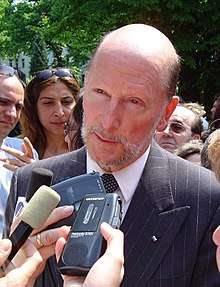
In 705 Emperor Justinian II named Tervel of Bulgaria "caesar", the first foreigner to receive this title, but his descendants continued to use Bulgar title "Kanasubigi". The sainted Boris I is sometimes retrospectively referred to as tsar, because at his time Bulgaria was converted to Christianity. However, the title "tsar" (and its Byzantine Greek equivalent basileus) was actually adopted and used for the first time by his son Simeon I, following a makeshift imperial coronation performed by the Patriarch of Constantinople in 913. After an attempt by the Byzantine Empire to revoke this major diplomatic concession and a decade of intensive warfare, the imperial title of the Bulgarian ruler was recognized by the Byzantine government in 924 and again at the formal conclusion of peace in 927. Since in Byzantine political theory there was place for only two emperors, Eastern and Western (as in the Late Roman Empire), the Bulgarian ruler was crowned basileus as "a spiritual son" of the Byzantine basileus.[5]
Some of the earliest attested occurrences of the titlo-contraction "tsar" (car' ) from "tsesar" (cěsar' ) are found in the grave inscription of the chărgubilja (ichirgu-boil) Mostich, a contemporary of Simeon I and Peter I, from Preslav.
It has been hypothesized that Simeon's title was also recognized by a papal mission to Bulgaria in or shortly after 925, as a concession in exchange for a settlement in the Bulgarian-Croatian conflict or a possible attempt to return Bulgaria to union with Rome. Thus, in the later diplomatic correspondence conducted in 1199–1204 between the Bulgarian ruler Kaloyan and Pope Innocent III, Kaloyan—whose self-assumed Latin title was "Imperator Bulgarorum et Blachorum"—claims that the imperial crowns of Simeon I, his son Peter I, and Samuel were somehow derived from the papacy. The pope, however, only speaks of reges (kings) of Bulgaria in his replies, and eventually grants only that lesser title to Kaloyan, who nevertheless proceeds to thank the pope for the "imperial title" conferred upon him.[6]
The title, later augmented with epithets and titles such as autocrat to reflect current Byzantine practice, was used by all of Simeon's successors until the complete conquest of Bulgaria by the Ottoman Empire in 1422. In Latin sources the emperor of Bulgaria is sometimes designated "emperor of Zagora" (with variant spellings). Various additional epithets and descriptions apart, the official style read "Emperor and Autocrat of all Bulgarians and Greeks".
During the five-century period of Ottoman rule in Bulgaria, the sultan was frequently referred to as "tsar". This may be related to the fact that he had claimed the legacy of the Byzantine Empire or to the fact that the sultan was called basileus in medieval Greek.
After Bulgaria's liberation from the Ottomans in 1878, its new monarchs were at first autonomous prince (knyaz). With the declaration of full independence, Ferdinand I of Bulgaria adopted the traditional title "tsar" in 1908 and it was used until the abolition of the monarchy in 1946. However, these titles were not generally perceived as equivalents of "emperor" any longer. In the Bulgarian as in the Greek vernacular, the meaning of the title had shifted[7] (although Paisius' Slavonic-Bulgarian History (1760–1762) had still distinguished between the two concepts). Accordingly, while Ferdinand and his successors, Boris III and Simeon II, used the title of "tsar" in Bulgarian, they used the title of "king" outside Bulgaria. In the same fashion, the modern rulers of Greece (1821–1923, 1935–1973) used the traditional title of basileus in Greek and the title of "king" when in English speaking countries.
Kievan Rus'
"Tsar" was used once by church officials of Kievan Rus' in the naming of Yaroslav the Wise of Kiev. This may be connected to Yaroslav's war against Byzantium and to his efforts to distance himself from Constantinople. However, other princes of Kievan Rus' never styled themselves as tsars.[8] Russian lands used the term tsar from 1547 when Knyaz (Russian: Князь) Ivan IV the Terrible was officially crowned tsar of all Russia.[9]
Serbia
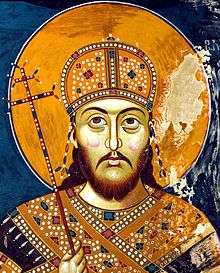
The title of tsar (Serbian car) was used officially by two monarchs, the previous monarchial title being that of king (kralj). In 1345, Stefan Dušan began to style himself "Emperor of Serbs and Greeks" (the Greek renderings read "basileus and autokrator of Serbs and Romans"), and was crowned as such in Skopje on Easter (April 16) 1346 by the newly elevated Serbian patriarch, alongside the Bulgarian patriarch and archbishop of Ohrid. On the same occasion, he had his wife Helena of Bulgaria crowned as empress and his son associated in power as king. When Dušan died in 1355, his son Stefan Uroš V became the next emperor. The new emperor's uncle Simeon Uroš (Siniša) contested the succession and claimed the same titles as a dynast in Thessaly. After his death around 1370, he was succeeded in his claims by his son John Uroš, who retired to a monastery in about 1373.
With the extinction of the Nemanjić dynasty in Serbia in 1371, the imperial title became obsolete (though it was retained by Stefan Uroš IV's widow Elena of Bulgaria until her death in 1376/1377). The royal title was preserved by Vukašin Mrnjavčević, a Serbian ruler in Macedonia, who had been associated by Stefan Uroš. Several other Serbian rulers are known as tsars, although they were never recognized as such. These include Tsar Lazar (who was titled autokrator), Tsar Jovan Nenad (self-given) and Tsar Stephen the Little (who claimed to be the Russian Emperor in Montenegro).
During the period of the Ottoman rule in Serbia, the sultan was also frequently referred to as tsar, for instance in Serbian epic poetry.
Russia
The first Russian ruler to openly break with the khan of the Golden Horde, Mikhail of Tver, assumed the title "basileus of Rus" and "czar", more commonly spelled "tsar".[10]
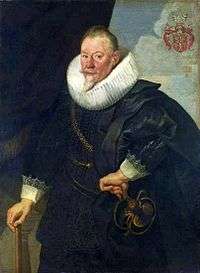
Following his assertion of independence from the khan, "Veliki Kniaz" Ivan III of Muscovy started to use the title of tsar (Russian: Царь) regularly in diplomatic relations with the West. From about 1480, he is designated as "imperator" in his Latin correspondence, as "keyser" in his correspondence with the Swedish regent, as "kejser" in his correspondence with the Danish king, Teutonic Knights, and the Hanseatic League. Ivan's son Vasily III continued using these titles. Sigismund von Herberstein observed that the titles of "kaiser" and "imperator" were attempts to render the Russian term "tsar" into German and Latin, respectively.[11]

This was related to Russia's growing ambitions to become an Orthodox "Third Rome", after the Fall of Constantinople. The Muscovite ruler was recognized as an emperor by Holy Roman Emperor Maximilian I in 1514.[12][13][14] However, the first Russian ruler to be formally crowned as Tsar of All Rus (Russian: Царь Всея Руси) was Ivan IV, until then known as Grand Prince of all the Russias. Some foreign ambassadors—namely, Herberstein (in 1516 and 1525), Daniel Printz a Buchau (in 1576 and 1578) and Just Juel (in 1709)—indicated that the word "tsar" should not be translated as "emperor", because it is applied by Russians to David, Solomon and other Biblical kings, who are simple reges.[15] On the other hand, Jacques Margeret, a bodyguard of False Demetrius I, argues that the title of "tsar" is more honorable for Muscovites than "kaiser" or "king" exactly because it was God and not some earthly potentate who ordained to apply it to David, Solomon, and other kings of Israel.[16] Samuel Collins, a court physician to Tsar Alexis in 1659-66, styled the latter "Great Emperour", commenting that "as for the word Czar, it has so near relation to Cesar... that it may well be granted to signifie Emperour. The Russians would have it to be an higher title than King, and yet they call David Czar, and our kings, Kirrols, probably from Carolus Quintus, whose history they have among them".[17]
In 1610 Sigismund III of Poland manipulated his son Władysław IV's election as tsar of Russia while Polish forces held Moscow during the Time of Troubles following the death of Boris Godunov. His election, which never resulted in his assumption of the Muscovite throne, was part of an unsuccessful plan by Sigismund to conquer all of Russia and convert the population to Catholicism. As a young man Władysław showed ability as a military leader in operations against Muscovy (1617–18) and the Ottoman Empire (1621).[18]
In 1670, Pope Clement X expressed doubts that it would be appropriate for him to address Alexis as "tsar", because the word is "barbarian" and because it stands for an emperor, a title reserved for the Holy Roman Emperor. Abbot Scarlati's opined that the term is not translatable and therefore may be used by the Pope without any harm. In order to settle the matter and to assert his imperial ambitions more clearly, Peter I the Great issued an edict that raised Russia to an empire and decreed that the Latin title imperator should be used instead of tsar (1721).
The title tsar remained in common usage, and also officially as the designator of various titles signifying rule over various states absorbed by the Muscovite monarchy (such as the former Tatar khanates and the Georgian Orthodox kingdom). In the 18th century, it was increasingly viewed as inferior to "emperor" or highlighting the oriental side of the term.[19] Upon annexing Crimea in 1783, Catherine the Great adopted the hellenicized title "tsaritsa of Tauric Chersonesos", rather than "tsaritsa of the Crimea". By 1815, when a large part of Poland was annexed, the title had clearly come to be interpreted in Russia as the equivalent of Polish król ("king"), and the Russian emperor assumed the title "tsar of Poland".[20]
Since the word "tsar" remained the popular designation of the Russian ruler despite the official change of style, it is commonly used in foreign languages such as English.
Metaphorical uses
Like many lofty titles, such as mogul, tsar or czar has been used in English as a metaphor for positions of high authority since 1866 (referring to U.S. President Andrew Johnson), with a connotation of dictatorial powers and style, fitting since "autocrat" was an official title of the Russian Emperor (informally referred to as 'the tsar'). Similarly, Speaker of the House Thomas Brackett Reed was called "Czar Reed" for his dictatorial control of the House of Representatives in the 1880s and 1890s.
In the United States and in the United Kingdom the title "czar" is a colloquial term for certain high-level civil servants, such as the "drug czar" for the director of the Office of National Drug Control Policy (not to be confused with a drug baron), "terrorism czar" for a presidential advisor on terrorism policy, "cybersecurity czar" for the highest-ranking Department of Homeland Security official on computer security and information security policy, and "war czar" to oversee the wars in Iraq and Afghanistan. More specifically, a czar in the US government typically refers to a sub-cabinet-level advisor within the executive branch. One of the earliest known usages of the term was for Judge Kenesaw Mountain Landis, who was named commissioner of baseball, with broad powers to clean up the sport after it had been sullied by the Black Sox scandal of 1919.[21]
See also
- List of Bulgarian monarchs
- List of Russian rulers
- List of Serbian monarchs
- Tsarina
- Tsesarevich
References
Citations
- Ivan Biliarsky, Word and Power in Mediaeval Bulgaria, East Central and Eastern Europe in the Middle Ages, 450-1450, BRILL, 2011, ISBN 9004181873, p. 211.
- "Simeon I." Encyclopædia Britannica. 2009. Encyclopædia Britannica Online. 12 July 2009, EB.com.
- "Online Etymology Dictionary". etymonline.com.
- Christina Holtz-Bacha, Encyclopedia of Political Communication, Volume 1, with Lynda Lee Kaid, Christina Holtz-Bacha as ed., SAGE, 2008, ISBN 1412917999. p. 115.
- Срђан Пириватрић. Самуилова држава. Београд, 1997.
- Innocentii pp. III epistolae ad Bulgariae historiam spectantes. Recensuit et explicavit Iv. Dujcev. Sofia, 1942.
- Найден Геров. 1895–1904. Речник на блъгарский язик. (the entry on цар in Naiden Gerov's Dictionary of the Bulgarian Language)
- Wladimir Vodoff. Remarques sur la valeur du terme "czar" appliqué aux princes russes avant le milieu du 15e siècle, in "Oxford Slavonic Series", new series, vol. XI. Oxford University Press, 1978.
- "Tsar | title". Encyclopedia Britannica. Retrieved 2019-05-21.
- A.V. Soloviev. "Reges" et "Regnum Russiae" au moyen âge, in "Byzantion", t. XXXVI. Bruxelles, 1966.
- "Den Titel aines Khaisers, wiewol Er alle seine Brief nur Reissisch schreibt, darinn Er sich Czar nent, so schickht Er gemaincklich Lateinische Copeyen darmit oder darinn, und an stat des Czar setzen sy Imperator, den wir Teutsch Khaiser nennen".
- Ostrowski, D. (2002) Muscovy and the Mongols: Cross-Cultural Influences on the Steppe Frontier, 1304-1589, Cambridge: Cambridge University Press, p. 178
- Lehtovirta, J. “The Use of Titles in Herberstein's "Commentarii". Was the Muscovite Tsar a King or an Emperor?” in Kӓmpfer, F. and Frӧtschner, R. (eds.) (2002) 450 Jahre Sigismund von Herbersteins Rerum Moscoviticarum Commentarii 1549-1999, Harrassowitz Verlag, pps. 196-198
- "Kayser vnnd Herscher aller Rewssen und Groszfürste zu Wolodimer" in the German text of Maximilian's letter; "Imperator et Dominator universorum Rhutenorum et Magnus Princeps Valadomerorum" in the Latin copy. Vasily III responded by referring to Maximilian as "Maximiliano Dei gratia Electo Romanorum Caesare", i.e., "Roman Caesar". Maximilian's letter was of great importance to Ivan the Terrible and Peter the Great, when they wished to back up their titles of "tsar" and "emperor", respectively. Both monarchs demonstrated the letter to foreign ambassadors; Peter even referred to it when he proclaimed himself Emperor.
- This objection may be used against translating "Basileus" as "emperor", too. Based on these accounts, the Popes repeatedly suggested to confer on the Russian monarchs the title of rex ("king"), if they only ally themselves with Vatican. Such a proposal was made for the last time in 1550, i.e., three years after Ivan IV had crowned himself tsar. As early as 1489, Ivan III declined the papal offer, declaring that his regal authority does not require anyone's confirmation.
- "Et ainsi retiennent le nom de Zar comme plus autentique, duquel nom il pleut iadis à Dieu d'honorer David, Salomon et autres regnans sur la maison de Iuda et Israel, disent-ils, et que ces mots Tsisar et Krol n'est que invention humaine, lequel nom quelqu'un s'est acquis par beaux faits d'armes".
- The Present State of Russia, in a Letter to a Friend at London. Written by an Eminent Person residing at Great Tzars Court at Mosco for the space of nine years. 2nd ed. London, 1671. Pages 54–55.
- "Wladyslaw IV Vasa - biography - king of Poland". Encyclopædia Britannica.
- Boris Uspensky. Царь и император: помазание на трон и семантика монарших титулов. Moscow: Языки русской культуры, 2000. ISBN 5-7859-0145-5. Pages 48–52.
- "The Brockhaus and Efron Encyclopedia entry on Tsar". Retrieved 2006-07-27.
- James K. Glassman (December 18, 2000). "Close, But No Big Czar". Reason magazine.
Bibliography
- Michael and Natasha, The Life and love of the Last Tsar of Russia, Rosemary & Donald Crawford, Weidenfeld & Nicolson, London 1997. ISBN 0-297-81836-8
- George Ostrogorsky, "Avtokrator i samodržac", Glas Srpske kraljevske akadamije CLXIV, Drugi razdred 84 (1935), 95-187
- John V.A. Fine, Jr., The Early Medieval Balkans, Ann Arbor, 1983
- John V.A. Fine, Jr., The Late Medieval Balkans, Ann Arbor, 1987
- Robert O. Crummey, The Formation of Muscovy 1304–1613, New York, 1987
- David Warnes, Chronicle of the Russian Tsars, London, 1999
- Matthew Lang (Editor), The Chronicle - $10 Very Cheap, Sydney, 2009/10
External links
| Look up tsar in Wiktionary, the free dictionary. |
| Wikimedia Commons has media related to Tsars. |
| Wikisource has the text of the 1911 Encyclopædia Britannica article Tsar. |
.svg.png)